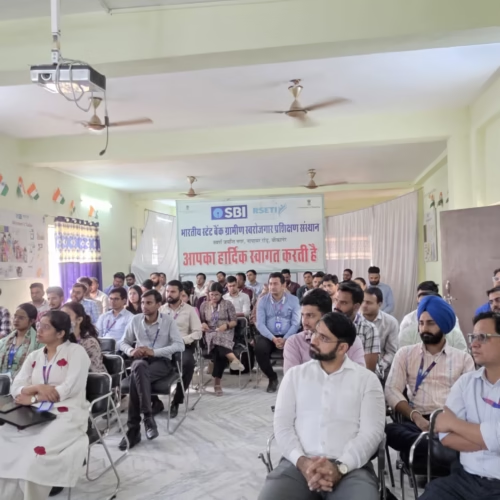The Silent Scourge: How Pesticides Are Devastating Global Wildlife – The Heartbreaking Story of Tigress Arrowhead
By Professor Mamta Sharma
In the sprawling forests, vibrant wetlands, and fertile agricultural landscapes across the world, a silent killer lurks—unseen, odorless, and often ignored. This killer is not a poacher hiding behind a tree line or an encroacher clearing forests for development. Instead, it comes in the form of minute particles—chemical pesticides—introduced by human hands with the intention of protecting crops and controlling pests, yet leaving behind a trail of devastation that is pushing our wildlife towards extinction.
The death of Ranthambore National Park’s famed tigress, T-84, popularly known as Arrowhead, serves as a heartbreaking symbol of this overlooked environmental catastrophe. While many wildlife deaths make headlines due to human-animal conflicts or poaching, Arrowhead’s slow and painful decline is a testament to a far more insidious threat—pesticide contamination that infiltrates entire ecosystems, leaving no creature untouched.
Tigress Arrowhead: A Legacy Lost to Chemicals
In the rugged terrain of Rajasthan’s Ranthambore National Park, Arrowhead roamed with the grace, power, and authority befitting an apex predator. She was easily recognizable, not just by her muscular frame and majestic presence, but by a distinctive, arrow-shaped marking on her body—a mark that earned her the name Arrowhead.
Yet, her significance extended far beyond her striking appearance. She was the granddaughter of Machhli, the legendary tigress of Ranthambore, often called the “Queen of the Jungle” or “Lady of the Lake.” Machhli’s life and legacy have been immortalized in wildlife documentaries, conservation campaigns, and countless visitor memories. Her lineage represents decades of conservation success, genetic strength, and the fragile hope for tiger populations across India.
Arrowhead carried this legacy forward. Her unusual and remarkable skill in hunting crocodiles set her apart from her peers. While most tigers prey on deer, wild boar, and other terrestrial animals, Arrowhead’s ability to hunt aquatic predators like crocodiles demonstrated her adaptability and strength—a reflection of the rich biodiversity and ecological complexity of Ranthambore.
Her unexpected demise, however, was not the result of territorial clashes or human intervention. It was a silent, internal assault—a bone tumor that progressively weakened her, eroding her hunting abilities and, ultimately, claiming her life. Though tumors can have multiple causes, a growing body of scientific evidence points towards environmental toxins—particularly pesticides—as significant contributors to such health crises in wildlife.
The Unseen Killer: How Pesticides Travel the Food Chain
Pesticides, originally developed as a tool to safeguard crops and control disease vectors, have now become omnipresent in our environment. These chemicals are not confined to the agricultural fields where they are sprayed. Instead, they travel—through soil, water, and air—seeping into ecosystems, contaminating water bodies, and infiltrating food chains.
The Journey of Pesticides Through the Ecosystem
- Environmental Persistence
Pesticides are designed to be potent and long-lasting. Many modern pesticides, particularly organochlorines and neonicotinoids, do not break down easily. They linger in the soil, leach into groundwater, run off into rivers and lakes, and evaporate into the atmosphere, traveling miles from their original application sites. - Contaminated Prey
Small organisms such as insects, rodents, amphibians, and fish ingest these chemicals either directly or indirectly:- Insects feed on contaminated plants.
- Rodents consume pesticide-laden seeds or prey on smaller contaminated animals.
- Fish absorb pesticides from polluted water sources.
- Biomagnification
The most alarming aspect of pesticide contamination is biomagnification—the process by which toxic substances accumulate in increasingly higher concentrations as they move up the food chain.- A small fish consumes hundreds of contaminated aquatic organisms.
- A larger predator eats many of these smaller fish.
- An apex predator like a tiger, eagle, or leopard consumes numerous contaminated prey over its lifetime.
By the time the chemicals reach the apex predators, the concentration of toxins in their bodies is exponentially higher than in the environment itself, rendering them vulnerable to disease, reproductive failure, neurological disorders, and death.
The Health Crisis in Wildlife: A Multifaceted Attack
The health consequences of pesticide exposure in wildlife are severe, diverse, and often irreversible. Scientific studies across the globe have documented a range of impacts, many of which mirror the slow, debilitating decline witnessed in Arrowhead.
1. Carcinogenic Effects
Several widely used pesticides contain carcinogenic compounds—substances known to induce cancer. Bone tumors, like the one that afflicted Arrowhead, are among the potential outcomes of prolonged exposure to these toxins. Cancer in wildlife is especially dangerous because it undermines an animal’s ability to hunt, evade predators, reproduce, or care for offspring.
2. Neurological Damage
Many pesticides, particularly organophosphates and neonicotinoids, are potent neurotoxins. They disrupt the nervous system, leading to:
- Seizures, tremors, and disorientation.
- Behavioral abnormalities, including aggression or lethargy.
- Impaired motor functions, making hunting or escape from predators difficult.
Such neurological impairments directly compromise survival in the wild.
3. Reproductive and Developmental Disorders
Pesticides known as endocrine disruptors interfere with hormonal systems in animals, leading to:
- Infertility and reduced sperm count.
- Feminization of male animals and masculinization of females.
- Birth defects, developmental delays, and high offspring mortality rates.
These effects are catastrophic for already endangered species struggling to sustain viable populations.
4. Immune System Suppression
Prolonged pesticide exposure weakens the immune response, making animals more susceptible to diseases, parasites, and infections that they would normally resist.
The Collapsing Web: Ecological Consequences of Pesticide Contamination
The tragedy extends far beyond individual animal health. Pesticide pollution disrupts entire ecosystems, triggering cascading effects that destabilize food webs, diminish biodiversity, and erode the natural processes that sustain life on Earth.
Apex Predator Decline
The loss of apex predators like tigers, eagles, and leopards creates an ecological imbalance:
- Prey populations may explode, leading to overgrazing.
- Habitats degrade, impacting plant communities and soil health.
- Biodiversity declines as keystone species vanish.
Pollinator Loss
Bees, butterflies, and other pollinators are vital for plant reproduction and food production. Neonicotinoids and other pesticides have decimated pollinator populations, jeopardizing global agriculture and wild plant diversity.
Aquatic Ecosystem Collapse
Pesticides leaching into water bodies poison fish, amphibians, and aquatic invertebrates. This undermines freshwater biodiversity and the health of aquatic food chains, with consequences that ripple into terrestrial ecosystems.
The Human Fallout: We Are Not Immune
The same pesticides that infiltrate wildlife food chains also find their way onto our plates, into our water, and into our bodies:
- Residues on fruits, vegetables, and grains.
- Contaminated meat, fish, and dairy products.
- Drinking water pollution.
- Occupational exposure among agricultural workers.
The health impacts mirror those seen in wildlife:
- Increased cancer rates.
- Neurological disorders, including Parkinson’s disease.
- Reproductive issues and birth defects.
- Hormonal imbalances and immune system dysfunction.
Children, pregnant women, and those living in agricultural communities are particularly vulnerable.
The Global Dimension: A Widespread, Underestimated Crisis
The impact of pesticides on wildlife is not confined to India or Ranthambore. It is a global phenomenon:
- In North America, pesticide use has been linked to declining songbird populations and amphibian deformities.
- In Europe, scientific studies have documented alarming declines in insect biodiversity, including pollinators.
- In Africa, pesticide contamination threatens migratory birds and aquatic ecosystems.
- In Asia, beyond tigers, leopards, elephants, and other flagship species face health risks from contaminated prey.
This crisis cuts across ecosystems, continents, and species, silently unravelling the web of life.
A Wake-Up Call: Urgent Steps for Change
Arrowhead’s story is a powerful symbol of what is at stake. To halt this crisis, humanity must take decisive action to break free from the cycle of chemical dependency.
1. Transition to Sustainable Agriculture
- Promote organic farming practices that eliminate or minimize synthetic pesticide use.
- Support agroecological methods that enhance biodiversity, soil health, and natural pest control.
- Provide financial and technical assistance to farmers adopting safer practices.
2. Integrated Pest Management (IPM)
IPM offers a balanced, science-based approach to pest control:
- Prioritize biological control using natural predators and beneficial insects.
- Employ crop rotation, intercropping, and habitat diversification.
- Use pesticides as a last resort, with careful selection and minimal environmental impact.
3. Ban the Most Dangerous Chemicals
- Phase out highly toxic and persistent pesticides identified as threats to wildlife and human health.
- Enforce stricter regulations on pesticide production, sale, and application.
- Invest in research and development of safer, eco-friendly alternatives.
4. Environmental Monitoring and Accountability
- Establish comprehensive monitoring programs to track pesticide residues in soil, water, and wildlife.
- Make data publicly accessible to ensure transparency and informed decision-making.
- Hold manufacturers and users accountable for environmental contamination.
5. Raise Public Awareness
- Launch educational campaigns highlighting the risks of pesticide misuse.
- Encourage consumers to choose organic and sustainably produced food.
- Empower communities to advocate for environmental and health protections.
Conclusion: Arrowhead’s Legacy – A Call for Collective Responsibility
The death of Tigress Arrowhead is not merely a footnote in conservation history—it is a warning siren for humanity. Her decline symbolizes the far-reaching, often invisible impacts of human choices on the planet’s most vulnerable inhabitants.
If we continue down the current path, we risk not only losing majestic species like tigers but also destabilizing the natural systems that sustain human civilization.
The time for incremental change is over. What is needed is a bold, collective, and urgent global response—a rethinking of how we grow food, how we manage pests, and how we value the intricate, interconnected web of life.
The future of our wildlife, our environment, and our own health depends on it.












Add Comment